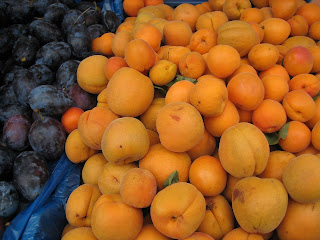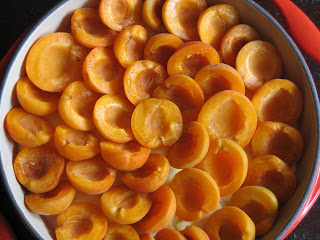Apricots are one fruit I actually prefer cooked. I’m not sure if it’s the slightly drier texture of the raw apricot, or the fact that, where even gentle cooking can diminish so many fruits’ fragrance and flavor, with apricots it brings them to their height.
 Tarte Tatin originated in 1889 at the Hotel Tatin in the Loire region town of Lamotte-Beuvron. There one of the Tatin sisters, Stéphanie, who handled most of their hotel’s cookery, was overworked one day and left the pie apples cooking too long in their butter and sugar before wrapping them in pastry. Tradition has it that when she smelled burning, Mademoiselle Tatin tried to salvage the apples by tucking a pastry base over them and giving them a speedy bake in the oven just to set the dough. Upon inverting the dish onto a serving plate, she found the deeply golden apples set into their crust and the whole dripping in a decadent apple caramel.
Tarte Tatin originated in 1889 at the Hotel Tatin in the Loire region town of Lamotte-Beuvron. There one of the Tatin sisters, Stéphanie, who handled most of their hotel’s cookery, was overworked one day and left the pie apples cooking too long in their butter and sugar before wrapping them in pastry. Tradition has it that when she smelled burning, Mademoiselle Tatin tried to salvage the apples by tucking a pastry base over them and giving them a speedy bake in the oven just to set the dough. Upon inverting the dish onto a serving plate, she found the deeply golden apples set into their crust and the whole dripping in a decadent apple caramel.
This version, irresistible in late summer, was inspired by another hotel – one further south in the ancient Roman town of Nîmes. Years ago, I spent a few days there, and our hotel’s garden was full of chestnut and apricot trees – all heavy with fruit in that late Provençale summer. A few heavenly hours in that fragrant garden still serve as a sensory reminder of how magically natural the combination of apricots and chestnut is, and it wasn’t long before I started adding a little chestnut flour to my apricot Tarte Tatin. I find the gentle nuttiness and slight smokiness of the chestnuts really come out once the pie has had a chance to cool down a little.
 Just be sure to turn the tart out as soon as you take it from the oven. Any apricots left in the baking dish can be rearranged once the tart is on the plate. And use a serving dish with a rim, as the caramel in this recipe is runnier than in the traditional apple Tarte Tatin. There’s no need to braise the apricots first as you do with apples, and I’ve kept the caramel light as I’m particularly fond of the way this, along with a little Grand Marnier or orange flower water, brings out the intensity of the apricots without over-sweetening.
Just be sure to turn the tart out as soon as you take it from the oven. Any apricots left in the baking dish can be rearranged once the tart is on the plate. And use a serving dish with a rim, as the caramel in this recipe is runnier than in the traditional apple Tarte Tatin. There’s no need to braise the apricots first as you do with apples, and I’ve kept the caramel light as I’m particularly fond of the way this, along with a little Grand Marnier or orange flower water, brings out the intensity of the apricots without over-sweetening.
Serves 6 – 8
- ¾ cup all-purpose flour, plus extra for dusting
- ¼ cup chestnut flour or all-purpose flour
- ½ tsp kosher salt
- 5 tbsp granulated sugar
- 6 tbsp unsalted butter, chilled and cubed
- 1 egg, cold
- 2 tbsp unsalted butter, room temperature
- ¾ cup granulated sugar
- ½ cup water
- 1 ½ lbs fresh apricots, sliced in half lengthwise, stones removed
- 1 tbsp Grand Marnier (or other orange liqueur, or orange flower water)
- 2 pinches kosher salt
In a food processor, pulse the flours, salt, and sugar to combine. Add the cold cubes of butter and pulse until the mixture looks like oatmeal. Add the egg and pulse a few more times until the pastry dough just comes together into a ball.
Working quickly to keep the mixture as cold as possible, dust your hands with a little flour and transfer the pastry dough, which will be quite sticky, onto a piece of parchment paper. Press the dough out into a 10-inch circle, cover with more parchment paper, and chill in the fridge for at least 1 hour.
When you’re ready to proceed, preheat the oven to 400 F and use the 2 tbsp of room temperature butter to coat the inside of a heavy 9-inch round baking dish.
Carefully pour the ¾ cup of sugar and the ½ cup water into a small saucepan over medium-high heat. Plunge your hands into your pockets or wring them behind your back, but do not stir or swirl – you must resist the urge to do so, or the whole thing can crystallize, and you shall have to start over. Allow the mixture to bubble just until it takes on a tiny bit of golden color – about 10 – 15 minutes, but watch it closely.
Once the caramel is very lightly golden, pour into the baking dish. Working quickly to finish before the caramel hardens too much, arrange the apricots on their sides, all facing the same way with the skin side slightly down, in a circle around the outside of the dish (see photo above). Complete another circle in the same way, and then another. Sprinkle the apricots with the Grand Marnier and then with a couple of pinches of kosher salt.
Peel one piece of parchment off the pastry dough and invert the circle over the baking dish. Gently peel off the other piece of parchment and tuck the overhang into the baking dish against the inside edge. Pierce several slits in the pastry with a sharp knife.
Place the baking dish on a sheet pan to catch any bubbled-over cooking juices and bake in the middle of the oven for 45 minutes or until the crust is golden brown. Remove and immediately invert onto a serving plate with a rim to catch the caramel.
Allow to cool for 30 minutes before slicing and serving, or wait until it’s room temperature. Either way, the tart is delicious alone and lovely with a little crème fraiche.
Tarte Tatin originated in 1889 at the Hotel Tatin in the Loire region town of Lamotte-Beuvron. There one of the Tatin sisters, Stéphanie, who handled most of their hotel’s cookery, was overworked one day and left the pie apples cooking too long in their butter and sugar before wrapping them in pastry. Tradition has it that when she smelled burning, Mademoiselle Tatin tried to salvage the apples by tucking a pastry base over them and giving them a speedy bake in the oven just to set the dough. Upon inverting the dish onto a serving plate, she found the deeply golden apples set into their crust and the whole dripping in a decadent apple caramel.
Just be sure to turn the tart out as soon as you take it from the oven. Any apricots left in the baking dish can be rearranged once the tart is on the plate. And use a serving dish with a rim, as the caramel in this recipe is runnier than in the traditional apple Tarte Tatin. There’s no need to braise the apricots first as you do with apples, and I’ve kept the caramel light as I’m particularly fond of the way this, along with a little Grand Marnier or orange flower water, brings out the intensity of the apricots without over-sweetening.


